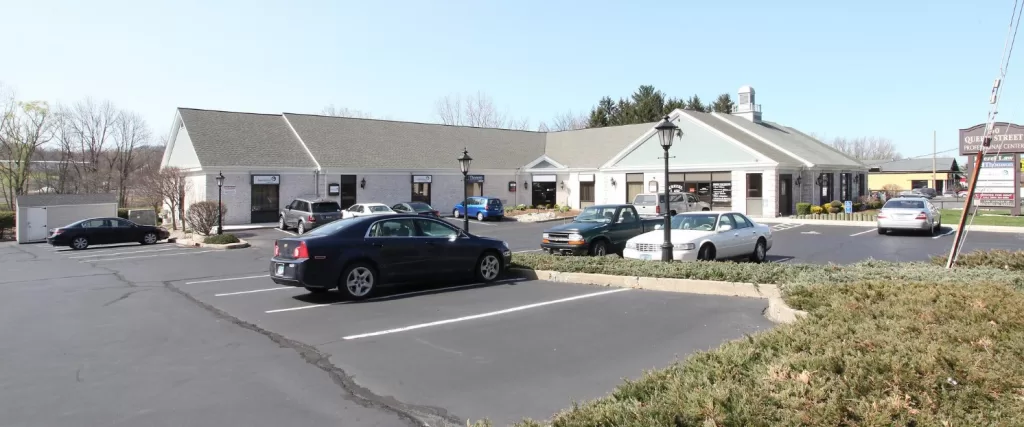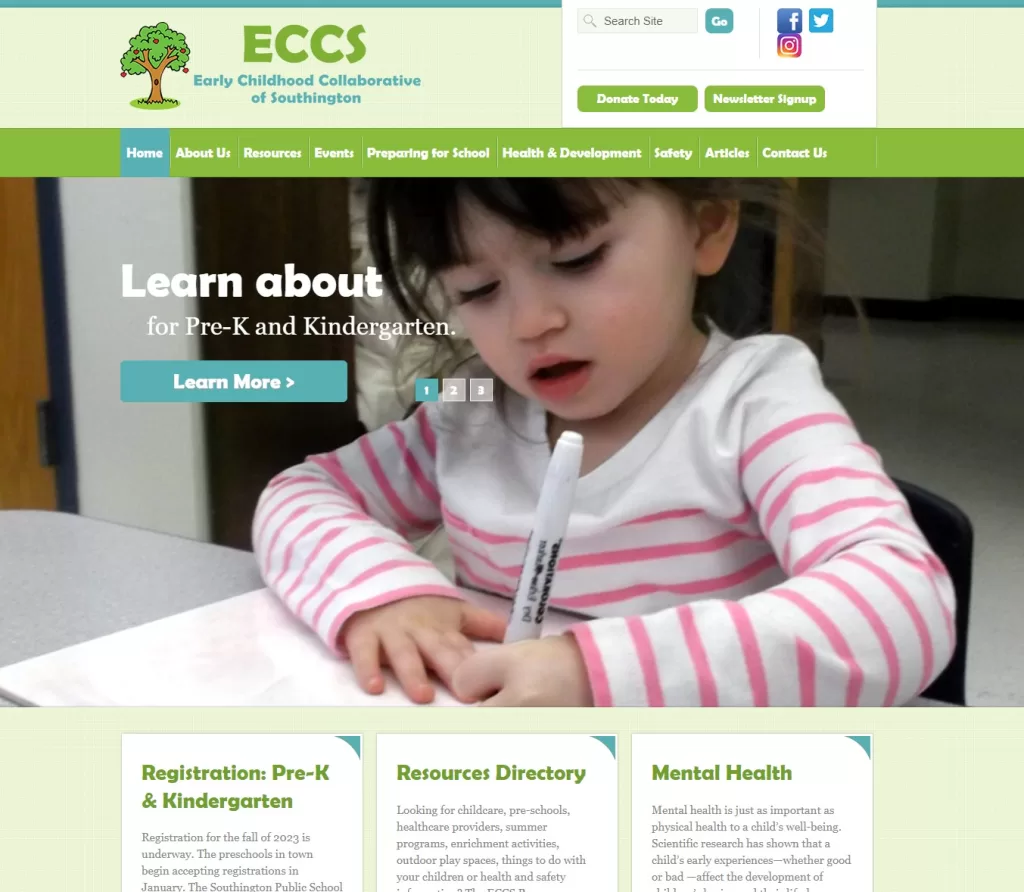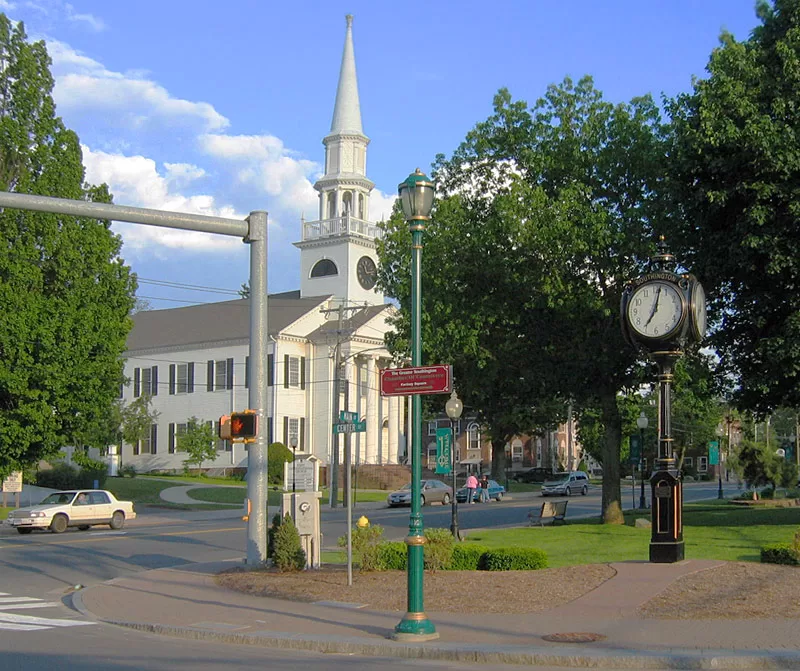Pinpoint Digital, LLC is currently located in Plainville but for many years our office was at 100 Queen Street in Southington (next to the Midas in the old Friendly’s building). Our owner, John Giaccotto, is a resident of Southington and his children attend its school system. Pinpoint Digital, LLC was founded in 2007 in Wallingford, Connecticut. In 2012 we moved into an office at 100 Queen Street in Southington and then in 2016 we moved to the Plainville Business & Professional Center. We have helped hundreds of Connecticut businesses build websites and achieve their online goals.

Southington Web Design Services
Custom Web Design, Branding & Logos
We work with a wide range of businesses and nonprofit organizations to help them communicate with their prospects and stakeholders. Our complete website design services can help you create a compelling website that speaks to your target demographic and effectively communicates your message. While most of our websites are custom designed from the ground up we do offer templates for certain industries. We can also design logos as well as modernize and cleanup existing logos.


Copywriting
Most of our clients prefer to write their own copy because they intimately understand their business. However, for those clients who want a more hands-off approach we provide copywriting services. We write compelling and engaging content that not only informs but also converts visitors into prospects.
Digital Marketing
We provide the following digital marketing services.
- Google Ads Management
- Local Service Ads Setup and Management
- Search Engine Optimization
- Local Google My Business (GMB) Optimization
Content Management Systems
Our preferred content management system is WordPress which is the most popular content management system. While we do work with other content management systems such as Drupal we do 99% of our website projects using WordPress.

Custom Web Development
We are experts at creating custom web applications. These include custom e-commerce solutions, workflow management solutions and many other types of applications. We build a lot of customizations with WordPress through creating custom plugins. For those projects where WordPress is not a good fit we use the Laravel PHP framework. All of our custom web development projects include some sort of requirements gathering and specifications development project. We also perform a robust quality assurance or testing phase to help ship applications free of bugs and issues.

Our Location
We are located 55 Whiting Street, Suite 3B, in Plainville, Connecticut.
Get in Touch
Whether you’re a small startup or a nonprofit looking for a Plainville CT web design company, we’re here to help you succeed online. At Pinpoint Digital, LLC, we believe that your success is our success. Contact us today to discuss your web design, branding, copywriting, or digital marketing needs. We provide web design services throughout Connecticut, including Putnam, Meriden, Hartford and Bridgeport.
Websites:



About Southington, Connecticut
Discovering the Charming Town of Plainville, Connecticut
Connecticut is renowned for its picturesque towns and rich history, and Plainville is no exception. Nestled in Hartford County, this quaint town is part of the Capitol Planning Region and has a unique blend of history, natural beauty, and a thriving community. As of the 2020 United States Census, Plainville boasted a population of 43,501 residents and was known for its charming villages of Marion, Milldale, and Plantsville.
A Glimpse into the Past
Although officially established as a town in 1779, Plainville’s roots run much deeper into history. It all began with Samuel Woodruff, the town’s first white settler, who moved to the area in 1698 when it was known as “Panthorne.” This land was once inhabited by the Tunxis or Sepores Indians, adding to its rich historical tapestry.
Plainville’s historical significance extends beyond its early settlers. One of its most notable visitors was General George Washington himself, who passed through the town in 1770 on his way to Wethersfield, leaving behind traces of his legacy.
One of Plainville’s historic gems is the Marion section, which played host to the great French general, Jean-Baptiste Donatien de Vimeur, comte de Rochambeau, during the American Revolutionary War. In June 1781, French troops under Rochambeau’s command camped in the Marion section of Plainville, leaving an indelible mark on the town’s history. A marker on Marion Avenue commemorates this historic event, and the area has become known as French Hill.
From Farms to Industry
Plainville’s history reflects the evolution of many Connecticut towns. Initially, it was a small, rural farming community. However, in the early 1900s, Plainville transformed into a manufacturing center, marking a significant shift in its character.
The town can proudly claim the invention of various products that contributed to the industrial landscape of Connecticut, including the first underwater-hardening cement, the first carriage bolt cutting machine, and even the break-neck rat trap. The innovative spirit of Plainville residents shaped its industrial identity.
Modern Transformation
With the decline of industry in New England and the construction of Interstate 84 in the mid-1960s, Plainville underwent a substantial transformation. It evolved into a thriving bedroom community, experiencing explosive growth. Today, Plainville’s population has surged to over 42,000 residents, with 28% of its workforce still employed in manufacturing, particularly in fabricated metals and aircraft production.
During World War II, Plainville was selected by the War Department to be highlighted in a defense booklet called “Southington, CT—Microcosm of America.” This publication aimed to showcase the typical American citizens, their traditions, and values to friends and foes in Europe. Thousands of copies were dropped from military airplanes over Europe during the Nazi German Occupation. The mural “Romance of Southington,” painted by Ann Hunt Spence in the town post office in 1942, is a testament to this historical period.
A Festival of Tradition and Community
Each year, Plainville hosts the beloved Apple Harvest Festival, a tradition that has been embraced by the town since 1969. Spanning six weekdays and two weekends, this festival brings together local businesses and residents from Plainville and surrounding cities. The festival’s highlights include a town parade, carnival rides and games, musical performances, and a wide variety of delicious food served by community organizations, including the Boy Scouts of America, local churches, and the Southington Fire and Police Departments. Plainville’s abundance of farms and apple orchards, including the largest in the state, Rogers Orchards, adds to the festival’s charm.
Natural Beauty and Outdoor Activities
Plainville’s geographic location enhances its appeal. Situated about 20 miles southwest of Hartford, it offers easy access to major cities while maintaining a serene, small-town atmosphere. The town’s picturesque landscape features two mountains on its east and west sides, with the Quinnipiac River flowing through its heart.
Outdoor enthusiasts will appreciate the presence of the Metacomet Ridge, a rugged trap rock mountain range that runs through Plainville. Notable peaks along the ridge form the eastern edge of town, offering hiking opportunities and breathtaking views.
Mount Southington ski area has been a favorite destination for winter sports enthusiasts since the 1960s, providing residents with convenient access to skiing and snowboarding.
Community and Education
Plainville’s strong sense of community is reflected in its dedication to education. The town’s public school system comprises eight elementary schools, two middle schools, and one high school. Additionally, the Karen Smith Academy serves as an alternative school for students in grades 8–12. With a growing enrollment, the town continually invests in expanding its school facilities to accommodate the needs of its students.
In addition to public education, Plainville is home to two parochial schools, Southington Catholic and Central Christian Academy, offering educational options for families in the area.
A Promising Future
Plainville’s revitalization efforts are evident in various projects aimed at preserving its history and enhancing its infrastructure. Recent initiatives include the downtown renaissance project, which beautified the town center with granite curbing, brick paving stones, iron lamp posts, and more.
The town’s linear walking trail, built over an old rail line, connects various neighborhoods and contributes to the ongoing revitalization of downtown Plainville. The expansion of public transportation, including CTfastrak, has improved connectivity to nearby cities.
As Plainville continues to evolve, its rich history and strong community spirit remain at the core of its identity. With its commitment to education, thriving festivals, and natural beauty, Plainville is a charming town that celebrates its past while looking forward to a promising future.
Exploring Southington, Connecticut: A Blend of History, Community, and Natural Beauty
Nestled in the heart of Hartford County, Connecticut, lies the charming town of Southington. With its rich history, tight-knit community, and picturesque landscapes, Southington is a place that beckons residents and visitors alike. Let’s take a journey through the town of Southington, exploring its past, present, and the many facets that make it a unique and vibrant community.
A Glimpse into History
Southington’s roots trace back to a time long before its formal establishment in 1779. Samuel Woodruff, the town’s first white settler, arrived in an area known as “Panthorne” in 1698, which had previously been occupied by the Tunxis or Sepores Indians. Over time, the settlement grew and transformed into “South Farmington” and, eventually, Southington.
One of the most notable historical events in Southington’s past was the visit of General George Washington in 1770 as he made his way to Wethersfield. The Marion section of Southington holds a special place in the town’s history. It served as an encampment for French General Jean-Baptiste Donatien de Vimeur, comte de Rochambeau, during the American Revolutionary War. In June 1781, Rochambeau and his troops camped in Southington for four days, leaving behind a legacy that is still celebrated today at French Hill.
From Farming to Industry
Originally a small farming community, Southington experienced a significant transformation in the early 1900s when it evolved into a manufacturing hub. Despite this shift, the town’s population remained relatively small until the mid-1960s when Interstate 84 was constructed. This development led to explosive growth, and today, Southington boasts a population of over 43,000 residents.
Manufacturing still plays a significant role in Southington’s economy, with 28% of the workforce employed in this sector. The town has a proud history of innovation, with inventions like the first cement that could harden underwater, the first carriage bolt cutting machine, and even a break-neck rat trap originating here.
A Glimpse into the Past
During World War II, Southington gained national attention when it was featured in a defense booklet called “Southington, CT—Microcosm of America.” This publication aimed to showcase the lives, traditions, and values of American citizens to friends and foes in Europe. Thousands of copies were dropped over Europe during the Nazi German Occupation.
Additionally, the town’s post office became home to the mural “Romance of Southington,” created by artist Ann Hunt Spence in 1942. This artwork was part of the larger effort to promote art during the Great Depression through government-funded projects like the Works Progress Administration (WPA).
A Taste of Tradition: The Apple Harvest Festival
One cherished tradition in Southington is the Apple Harvest Festival, which has been celebrated since 1969. This annual event aims to bring together local businesses and residents from Southington and neighboring towns. The festival spans six weekdays and two weekends and includes a town parade, carnival rides, games, musical performances, and a delectable array of unique recipes and foods served by community organizations, including the Boy Scouts, local churches, and more. Southington’s nickname, “The Apple Valley,” reflects the numerous apple orchards and farms that continue to thrive in the area, such as Rogers Orchards, the largest in the state.
Nature’s Beauty and Outdoor Activities
Southington’s geography offers a stunning backdrop for outdoor enthusiasts. Nestled in a valley with mountains on both its east and west sides, the town is a haven for nature lovers. The Quinnipiac River meanders through the landscape, and it is also home to the Mount Southington ski area, attracting visitors since the 1960s.
The Metacomet Ridge, a rugged mountain range, passes through the eastern edge of Southington, offering hiking opportunities with notable peaks like Bradley Mountain and Ragged Mountain. Roaring Brook, North Hamlin Brook, and Soltys Pond add to the town’s natural charm.
A Glimpse into the Present: Demographics
As of the 2020 census, Southington’s population stood at 43,501, reflecting a rich history of growth and community. The town is characterized by its diverse demographics, with a racial makeup of 89.6% White, 2.4% Black or African American, 2.9% Asian, and 3.7% of two or more races. Hispanic or Latino individuals make up 5.1% of the population, showcasing the town’s cultural diversity.
Southington’s residents span various age groups, with 23.8% under the age of 18 and 14.7% aged 65 or older. This demographic diversity adds to the town’s vibrancy and contributes to its unique character.
Economy and Employment
Southington’s economy is well-balanced, with a mix of manufacturing, healthcare, and local businesses. The town’s top employers include the Town of Southington, Hartford Healthcare, Webster Bank, and the Southington YMCA. Manufacturing still plays a vital role, particularly in fabricated metals and aircraft production.
Revitalization Efforts
As Southington has evolved over the years, it has undertaken revitalization projects to breathe new life into its infrastructure. The downtown renaissance project, completed in 2002, replaced sidewalks with granite curbing and brick paving stones, adorned with decorative iron lamp posts and benches. These efforts not only improved aesthetics but also enhanced the town’s sense of community.
The town’s water department also contributed to revitalization by developing a former facility site into a landscaped park, complete with sidewalks, iron fences, and decorative lamp posts. These projects have aimed to create a more welcoming and attractive environment for residents and visitors alike.
A Town Rich in Historic Charm
Southington takes pride in preserving its rich history and cultural heritage. Numerous houses and districts in Southington are listed on the National Register of Historic Places, each with its unique story and significance. These include the Luman Andrews House, Asa Barnes Tavern, and many more, offering a glimpse into the town’s past.

Education for the Future
Southington places a strong emphasis on education. The town boasts eight public elementary schools, two middle schools, and one high school, serving approximately 6,500 students. The commitment to education is evident in the ongoing expansion and renovation projects to accommodate the town’s growing student population.
In addition to public schools, Southington is home to two parochial schools, Southington Catholic and Central Christian Academy, offering educational alternatives to families in the area.
A Town Connected: Transportation
Southington’s connectivity is enhanced by its proximity to major highways, including Interstate 84 and Interstate 691. The town is also served by CTfastrak, Connecticut’s first bus rapid transit corridor, which provides efficient public transportation options for residents.
A Proud Community
Southington’s community spirit is evident in its numerous parks, recreation areas, and cultural institutions. Whether you’re strolling along the linear walking trail, enjoying the scenic beauty of Crescent Lake, or experiencing the thrills at Lake Compounce, there’s no shortage
of ways to connect with the community and enjoy the natural beauty that surrounds Southington.
In conclusion, Southington, Connecticut, is a town that seamlessly blends its rich history, diverse community, and natural beauty. From its roots as a farming community to its vibrant present, Southington stands as a testament to the enduring spirit of its residents and the timeless charm of small-town America. Whether you’re a history buff, an outdoor enthusiast, or simply seeking a welcoming community, Southington has something to offer everyone who visits or calls it home.